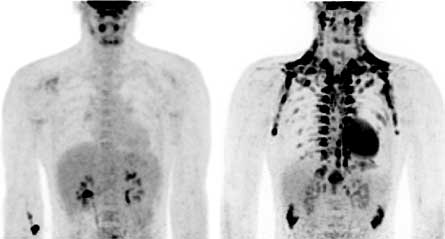Fighting fat with fat
Brown fat found in adults may help keep obesity at bay
The human body hides more than one kind of fat. White fat cells, which we usually think of when we think of fat, store energy. But brown fat is different: It’s a type of fat that burns energy and gives off heat.
When you were born, you had a pad of brown fat on your back, and it helped you control your body temperature. Mice also have brown fat on their backs. Until now, scientists suspected human adults don’t have brown fat — or if they do, the brown fat is not important.
Three recent studies show that human adults do have brown fat, and it may be important for controlling body weight. And unlike babies, adults store brown fat in the neck, abdomen, above the collarbone and along the spine.

In the first study, researcher Ronald Kahn of the Joslin Diabetes Center and Harvard Medical School in Boston looked at the medical records of nearly 2,000 people who had received a PET-CT scan. To get a PET, or positron emission tomography, scan, a person is injected with a chemical that emits particles called positrons. Inside the person’s body, these positrons create radiation called gamma rays, which pass through the body and are detected by special machines outside the body. This type of scan provides a three-dimensional picture of what’s going on inside the body. PET scans are often used to diagnose cancer. A CT scan uses X-rays to see inside a body.
Kahn and his team found brown fat in the scans of 3.1 percent of the men studied and 7.5 percent of the women. People younger than 50 and lean people were more likely to have brown fat.
“It is now without dispute that brown fat is present in adult humans,” Kahn says.
When the researchers checked the scans against the weather records, they found that brown fat was more likely to show up when the temperature outside was cold. This comparison suggests brown fat burns more energy in colder temperatures.
The connection between brown fat and temperature was explored in the second study. Dutch researchers took scans of lean and overweight men at two temperatures, 72 degrees Fahrenheit (room temperature) and 61 degrees Fahrenheit. At the higher temperature, brown fat barely appeared on the scans. But when the temperature dropped, brown fat appeared on the scans of the leaner men. The more overweight the man, the less brown fat appeared. The third study, conducted by Swedish scientists, also found evidence of brown fat in adults.
These studies suggest that brown fat may burn more energy in people who are lean. The connection between brown fat and being overweight is less clear. Scientists wonder: Does having less brown fat cause a person to become overweight, or does being overweight reduce the amount of brown fat in a person?
In other words, overweight people may be overweight partially because they don’t have enough brown fat to help burn energy. On the other hand, their excessive amount of white fat may keep the brown fat from burning energy.







